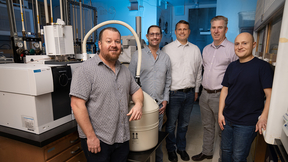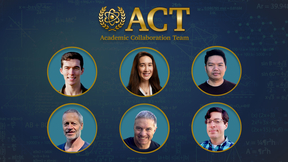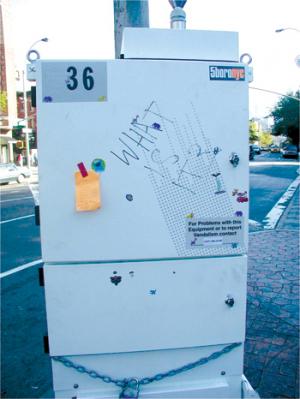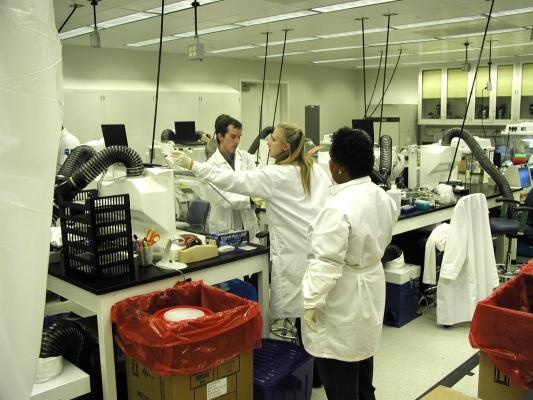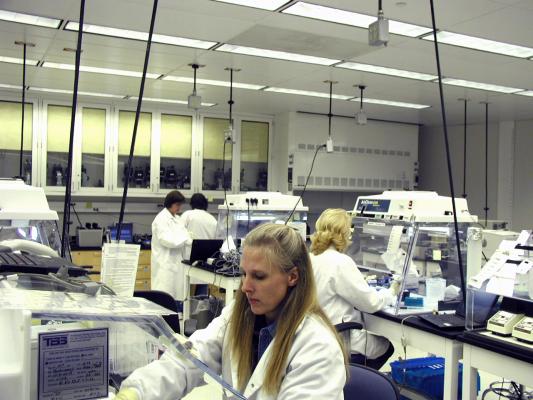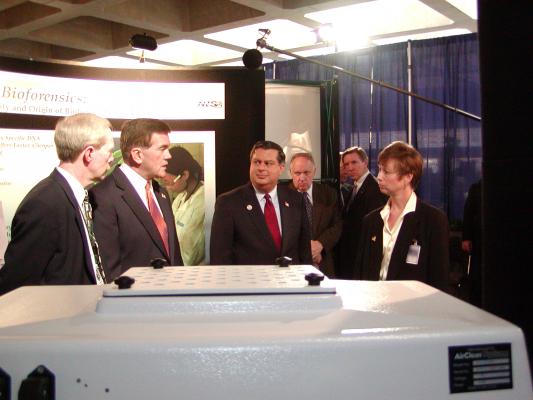How BASIS grew into the BioWatch system
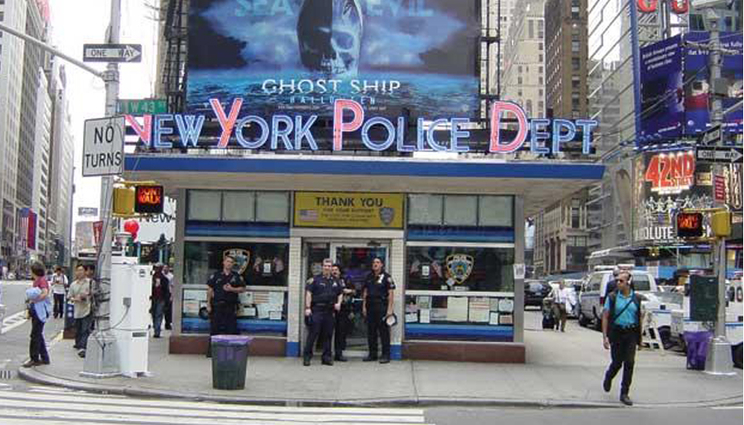 (Download Image)
(Download Image)
Air samples are collected by this BioWatch detector installed outside a New York City police station.
Editor's note: The following is part of a series of articles looking back at the Lab's response immediately following the Sept. 11 attacks and our contributions since that day 20 years ago.
Less than a month after 9/11, 14 Lawrence Livermore National Laboratory (LLNL) employees received calls at their homes at 1 a.m. on a Saturday morning (Oct. 6, 2001) and were asked to report to the Lab within three hours, without being told where they were going or when they would return.
Their mission, in tandem with colleagues from Los Alamos, was to place air sampling equipment in Washington, D.C. and to establish a sample processing laboratory. Since the spring of 2000, a team of biologists, computer scientists and engineers from both national laboratories had been developing a detection system that could alert authorities of bioterrorist attacks to protect American cities.
Known then as the Biological Aerosol Sentry and Information System, the BASIS detection system was developed at the behest of the Department of Energy (DOE), which wanted to field the system at the 2002 Salt Lake City Winter Olympics and have it ready a year early for a full-scale test.
The early readiness of BASIS in March 2001 turned out to be an asset for the nation later that year, following the 9/11 terrorist attacks and anthrax mailings, when the 1 a.m. call came and a detection system was needed to protect Washington, D.C. Now, more than two decades later, much of that system is still in place today and still operational.
Two decades of operation
Their instruments went into operation two days later, on Oct. 8, 2001. Since then, biodetection systems developed by Livermore and Los Alamos have continued to serve as a warning system against any biological attacks without interruption for nearly 20 years.
Though the system has undergone some major changes and is now called BioWatch, the biodetection technology operates today in more than 30 American cities under the Department of Homeland Security’s (DHS) Countering Weapons of Mass Destruction Office (CWMD).
Another BioWatch sensor resides in a New York City borough.
"BASIS was the blueprint for BioWatch,” said Lab molecular biologist Thomas Bunt, who was among the first five LLNL contractors hired to work on BASIS on the East Coast in 2001.
“BASIS was meant to be a deployable lab that was set up for two or three weeks to monitor special events, like political conventions or the Olympics. But then, after 9/11, we needed a permanent biodetection system that could be set up in dozens of cities around the country. The decision was to deploy BASIS because of an urgent need. It turned into a network of labs operating seven days a week, 365 days a year,” Bunt noted.
BASIS created a sea change for detection of terrorist releases of biological pathogens. Before 2001, bioagent detection relied on symptom surveillance by individual doctors and health department analysis of lab results. It could take days or even weeks to figure out if there had been a bioterrorist release.
A detect-to-treat technology, BASIS was designed to detect and locate an aerosol release of a biological pathogen quickly and accurately enough for a prompt response within 24 hours or less.
This is critical because the survival rate from exposure to the anthrax bacterium, for example, is high when antibiotic therapy can be administered before symptoms appear, but after symptoms manifest, the survival rate diminishes substantially.
After DOE called for two of its national labs to develop BASIS within a year, some people wondered whether the feat could be done. The decision also placed high pressure on the research team.
“There was a great deal of skepticism about whether we could pull this off,” said physicist Dennis Imbro, the LLNL principal investigator for BASIS, a 22-year Lab employee who retired in 2005. “We felt confident we could have the system ready, but there certainly was a lot of work to do, including integration with local health authorities.”
Tom Slezak, the now-retired former associate program leader for chemical-biological detection for Global Security, recalls feeling “incredible pressure” to have BASIS ready as an operational system.
Shown processing samples are current or former Lab employees (from left) Mark Wagner, Virginia Montgomery (now retired) and Hummi Badri (who later left the Lab).
‘You’re my only hope’
“Initially, our computational team was tasked to build a chain-of-custody tracking system,” Slezak said. “But by summer 2000, we were asked to develop a new way to design polymerase chain reaction (PCR) signatures to identify the pathogens. There were two major software development efforts under way in parallel by August.”
To this day, 21 years later, he remembers a phone call he received on a summer Sunday afternoon (Aug. 6, 2000) from a fellow Lab employee who didn’t initially identify herself as he worked in his backyard garden.
“Help me, Obi-wan Kenobi; you’re my only hope.”
Those words came from Paula Imbro, an LLNL geneticist and associate program leader for biology, who had been tasked with developing PCR signatures to identify anthrax and other pathogens for the BASIS instruments.
Imbro and her LLNL colleagues had developed PCR signatures manually and given them wet-lab testing — and all of them failed. They were zero-for-1,000 and none of their signatures could detect all virulent anthrax strains without also detecting benign anthrax.
“Can’t you computer geeks figure out a way to design PCR signatures computationally?” Imbro asked, to which Slezak responded: “Paula, that’s a great idea, but there’s not enough genomic data in the public database for pathogens and microbial near neighbors.”
In early summer 2000, there were only 62 complete bacterial genomes in the public database. Today, there are more than 354,000 complete microbial genomes.
Imbro then asked: “Can’t you try anyway?” It was a question that led to a revolutionary scientific change in designing PCR signatures for identifying pathogens — even with barely any genomic information available.
Designing assays for pathogens
After that, Slezak and his team — bioinformaticist Shea Gardner and computer scientists Marisa Torres and Tom Kuczmarski — became the world’s first scientists to start developing PCR assays for pathogens by computational methods.
One of their first tasks was to develop KPATH, a computational tool that helped the team design pathogen assays. Something like the call letters of a radio station, KPATH stood for “all pathogens, all the time” and captured genomic sequences, particularly for pathogens, once a week from the public database.
“When the team was developing assays, KPATH would search for unique genomic sequences that existed nowhere else for pathogens like anthrax,” noted Mark Wagner, a key player for designing the chain of custody software for BASIS and BioWatch.
Other LLNL researchers who made important contributions to KPATH were biologist Beth Vitalis and computer scientists Clinton Torres, Jason Smith and Nisha Mulakken.
A computer scientist in Global Security’s Computing Applications Division, Wagner has worked on the two biodetection systems for more than two decades. The Data Management System he developed with Slezak and Linda Ott for chain of custody received FBI approval and consisted of a bar code system for keeping track of aerosol samples from BASIS and BioWatch detectors.
Slezak’s team sent several hundred candidate assays for anthrax to Paula Imbro’s group for in-depth screening and the final candidates were sent to the Centers for Disease Control and Prevention (CDC). The CDC then validated four assays for identifying every deadly strain of anthrax and not falsely identifying any benign anthrax strains.
Even today, Paula Imbro gives Slezak and his team plaudits for a job well-done. “Tom Slezak and his team were awesome. No matter what we needed, I couldn’t come up with a challenge that they couldn’t meet. Every time we needed help, they were there,” she said.
By February 2001, the multi-disciplinary Livermore team had proved the computational approach for designing pathogen assays, producing assays for a half-dozen important pathogens for the BASIS detectors.
During the fall of 2001, after the 9/11 terrorist attacks, Lawrence Livermore and Los Alamos national laboratories set up detectors for the Biological Aerosol Sentry and Information System (BASIS) in the National Capital Region. Shown processing BASIS air filters are (from left) Lab employees Cheryl Strout and Patsy Gilbert, along with Virginia Montgomery and Kris Montgomery, who have both since retired from LLNL.
Preparing for the Winter Olympics
The next month, in March, about 25 researchers, half from Livermore and half from Los Alamos, met in Salt Lake City to convert a conference room into a fully functional biological laboratory that could process about 60 samples a day.
They processed samples for a week — and their demonstration one year ahead of the Salt Lake City Olympics was a success, just as was the deployment during the 2002 Winter Games.
During the Olympics, BASIS operated for 35 days at sports venues, urban areas and transportation hubs. In all, 2,200 air samples were analyzed.
In addition to the BASIS technical work, an unheralded part of the job was integrating the system with federal agencies and local health authorities. Dennis Imbro and his Los Alamos counterpart, Wiley Davidson, worked with the Environmental Protection Agency (EPA) on locating the BASIS detectors and other aspects, while Paula Imbro worked with the CDC on assays.
Integration efforts also encompassed the FBI, the Secret Service and the military. “We had to develop policies and procedures: if you detected a bioterrorist agent, then what happens next?” Paula Imbro asked. “We spent as much time dealing with the concept of operations for what we would do in the event of a bioterrorist attack as we did developing the technical aspects of the program.”
In addition to deployments at the 2002 Winter Olympics and in Washington, D.C. (where it has been in use since October 2001), BASIS was placed in Albuquerque in 2002 and New York City for the first anniversary of 9/11.
In 2003, DHS and the Office of Science and Technology Policy decided to stand up biological surveillance capabilities in multiple cities using BASIS and establishing BioWatch, along with working in partnership with the CDC, EPA, FBI and law enforcement authorities. BioWatch is now federally managed by the DHS CWMD.
DHS would site the aerosol collectors in different cities and then work with Laboratory Response Network (LRN) laboratories located within local public health facilities to set up BioWatch labs to process the aerosol filters and check for pathogen releases.
“It took a heavy lift to make the BASIS system into BioWatch and provide biosurveillance for cities all around the United States,” said Bunt, who was the LLNL BioWatch operations lead from 2004-07 and Lab program leader for BioWatch from 2007-13.
“Everything required a lot of logistics and thinking outside the box. How do you set up laboratories from scratch across the country? There were many procurements, city-specific needs to address and a lot of pieces of equipment had to be shipped for each BioWatch laboratory. We then had to get the equipment installed and running properly, as well as ensure the personnel at the 10–15 new laboratories were proficient with complex analytical methods and procedures.”
For six months to a year, aerosol filters from each of the cities were sent overnight to Livermore for analysis to determine whether pathogens had been released.
“LLNL provided the reach-back support to process the samples for each jurisdiction while the BioWatch laboratories were preparing to come online. One by one, each city would get up and running on their own and we’d get the word that they weren’t sending their samples to us anymore. It was great to see that transition happen and that we helped enable the BioWatch network to get off the ground,” Bunt recalled.
BioWatch started out as a carbon copy of BASIS and evolved over time, Slezak said, adding: “Even today, much of the DNA from BASIS remains in BioWatch.”
Dividing the work for BASIS
In the division of labor for BASIS between Los Alamos and LLNL, Los Alamos was responsible for the aerosol filter collectors, worked with EPA to model where to place the collectors and established plume modeling for use in siting collectors and for consequence management. Livermore researchers designed the assays, conducted analytical development for detecting pathogens, set up communications in the field and led the BASIS and BioWatch facilitated consequence management efforts.
Many of the ways LLNL designed BASIS aided in scaling up the system for the nationwide BioWatch program, in Slezak’s view. The PCR assays were funded as a joint effort between the LLNL bioinformatics team and the Lab assay research laboratory. The final assay candidates were then sent to the CDC for final screening and validated in collaboration with the LRN.
“This was the first time that a fully computational approach was used to design PCR assays and screened in a high-throughput manner; in the past, they were designed and screened individually and were burdened with false positives and false negatives,” Slezak said. “All of the laboratory procedures used in BASIS and later BioWatch also were developed in-house and established with the CDC as the accepted methods for processing environmental samples of this type.
“Another important innovation was that we developed a chain-of-custody lab tracking system that had to meet FBI approval. We had to use bar codes for everything in the process and used almost no typed input. This greatly reduced errors and helped us win approval..
When Bunt left as the Lab’s principal investigator for BioWatch in 2013, he was replaced by LLNL biologist Lewis Wogan, who has worked on the BioWatch program since 2005.
During Wogan’s tenure, the Lab has undertaken technical upgrades, such as higher throughput for the analysis lab that has allowed jurisdictions to put out more aerosol collectors.
“We have built a robust, accurate nationwide biological detection system and continue to enhance situational awareness for detecting pathogens,” Wogan said. “This is a pretty unique and special system.”
In addition to Wogan, other Lab employees who continue to work on BioWatch are Wagner, physicist Jeff Drocco and computational scientists Aram Avila-Herrera, Nisha Mulakken and Kris Chubb.
Reflecting on the use of the biodetection system now, Slezak said: “We certainly knew that BASIS had the potential for becoming a nationwide biological security system because it was the first system for urban monitoring ever built, but probably none of us would have suspected that it would be in full operation 20 years later.”
Contact
 Stephen Wampler
Stephen Wampler
[email protected]
(925) 423-3107
Related Links
Countering Weapons of Mass Destruction Office“Lab’s work provides BASIS for biodetection”
Tags
Global SecurityDefense
Science
Featured Articles

